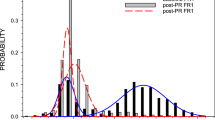Abstract
In order to study the relationship between pharmacologically induced hippocampal theta rhythm and resistance to extinction of instrumental responding, three groups of rats were trained on a discrete-trial FR 10 schedule of reinforcement, one group receiving injections of physostigmine (producing hippocampal theta rhythm) and the other two groups saline injections. This was followed by a noinjection phase for all three groups during which the schedule of reinforcement remained unchanged. In the extinction phase the drug-acquisition group and one of the saline acquisition groups received saline injections, while the remaining group received drug injections. Following extinction allSs went through reacquisition and a second extinction without any injections. The findings were that if physostigmine was administered during acquisition resistance to subsequent extinction was enhanced, but if it was administered during the extinction phase extinction was accelerated. The second acquisition and extinction did not yield any significant drug effects.
Similar content being viewed by others
References
Amsel, A.: Frustrative nonreward in partial reinforcement and discrimination learning. Psychol. Rev.69, 306–328 (1962).
- Behavioral habituation, counterconditioning, and a general theory of persistence. In: A. H. Black and W. F. Prokasy, eds. Classical Conditioning: II. Appleton-Century-Crofts 1972.
Banks, A., Russell, R. W.: Effects of chronic reduction in acetylcholinesterase activity on serial problem solving behavior. J. comp. physiol. Psychol.64, 262–267 (1967).
Glazer, H.: The septo-hippocampal system and persistence. Unpublished doctoral dissertation, University of Texas at Austin 1971.
Gray, J. A.: Sodium amobarbitol, the hippocampal theta rhythm, and the partial reinforcement extinction effect. Psychol. Rev.77, 465–480 (1971).
Shute, C. C. D., Lewis, P. T.: The ascending cholinergic reticular system: neocortical, olfactory, and subcortical projections. Brain90, 497–520 (1967).
Stumpf, C.: Drug action on the electrical activity of the hippocampus. Int. J. Neurobiol.14, 77–138 (1965).
Traupmann, K. L., Wong, P. T. P., Amsel, A.: Durability of persistence as a function of number of partially reinforced trials. J. exp. Psychol.88, 372–375 (1971).
Whitehouse, J. M.: The effects of physostigmine on discrimination learning. Psychopharmacologia (Berl.)9, 183–188 (1966).
Wong, P. T. P., Lee, C., Novier, F.: The partial reinforcement effect (PRE) sustained through extinction and continuous reinforcement in two strains of inbred mice. Psychonom. Sci.22, 141–143 (1971).
Author information
Authors and Affiliations
Additional information
The research herein reported was part of a dissertation submitted in partial fulfillment of the requirements of the Ph.D. at the University of Texas, and was supported by the National Science Foundation Grant GB-14990 X to Dr. Abram Amsel. Thanks are due to Dr. A. B. Combs, Department of Pharmacology, for his assistance with the pharmacological aspects of the study.
Rights and permissions
About this article
Cite this article
Glazer, H.I. Physostigmine and resistance to extinction. Psychopharmacologia 26, 387–394 (1972). https://doi.org/10.1007/BF00421904
Revised:
Issue Date:
DOI: https://doi.org/10.1007/BF00421904




